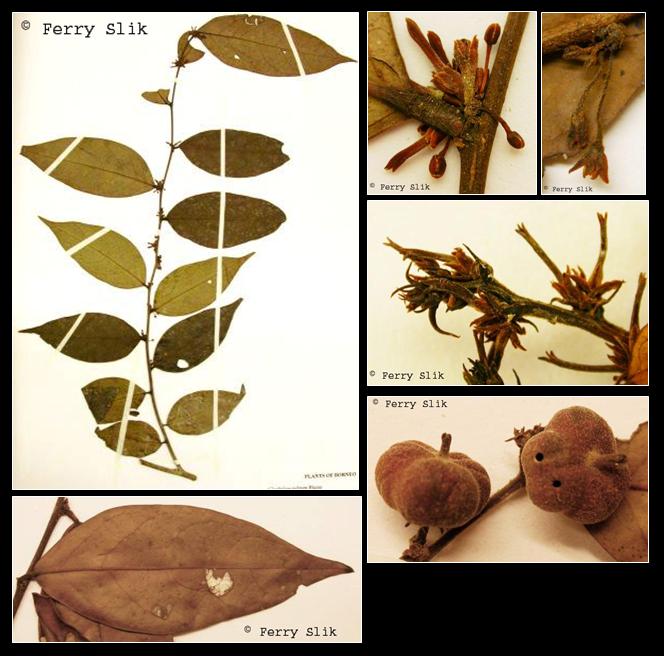Glochidion rubrum Blume, Bijdr. (1825)
Latin for 'red', referring to the reddish hairs that cover most of the plant.Synonyms
Bradleia coronata Wall. [Invalid]
Bradleia rubra (Blume) Steud.
Bridelia glauca Wall. [Invalid]
Diasperus coronatus (M¨šll.Arg.) Kuntze
Diasperus leiostylus (Kurz) Kuntze
Glochidion coronatum Hook.f.
Glochidion diversifolium (Miq.) Merr.
Glochidion foliosum S.Moore
Glochidion grave S.Moore
Glochidion insulare Hook.f.
Glochidion leiostylum Kurz
Glochidion penangense (Mull.Arg) Airy Shaw
Glochidion rubrum var. longistylus J.J.Sm.
Glochidion rubrum var. rubrum
Glochidion thorelii Beille in M.H.Lecompte
Glochidion versicolor S.Moore
Phyllanthus diversifolius Miq.
Phyllanthus penangensis Mull.Arg. in DC.
Diagnostics
Understorey tree up to 11 m tall and 20 cm dbh. Stipules ca. 3.5 mm long.
Leaves alternate, simple, penni-veined, glabrous. Flowers ca. 4 mm diameter,
white-yellowish, placed in axillary bundles. Fruits ca. 5 mm long, pinkish-red,
dehiscent capsules, seeds with orange aril.
Description
Shrubs to treelets up to 5(-15) m high, dbh up to 20 cm; flowering twigs 1-2 mm thick; glabrous to
hirsute all over. Leaves red when young; stipules deltoid, 3-4 by 0.8-2.2 mm, acuminate, very stiff,
late caducous; petiole 1.5-3 mm long; blade (ovate to) elliptic, 2.4-9.6(-13.7) by 1-3.8(-4.8) cm,
length/width ratio 1.4-2.8, chartaceous, base symmetric to asymmetric, attenuate to cuneate, margin
flat, apex bluntly acuminate to sharply cuspidate, mucronate or not, upper surface (sub)glabrous,
(dark) green, lower surface glabrous to hirsute, pale light green, venation flat above, slightly
raised underneath, indistinct, nerves 8-10 per side, veins scalariformly reticulate. Inflorescences
fascicles with a few staminate and/or pistillate flowers, usually less than 5 (to up to c. 10),
staminate flowers occasionally in short (less than 1 cm) racemes. Flowers greenish to (yellowish) whitish;
sepals 6, free. Staminate flowers 3.5-4.2 mm in diameter, pedicel 3.5-12 mm long, glabrous to
hirsute; sepals elliptic to obovate, outer ones 2.1-2.5 by 0.9-1.2 mm, inner ones 2.1-2.2 by
0.8-1 mm; stamens 3, androecium 0.8-1.3 mm long, anthers 0.6-0.9 mm long, light yellow to grey,
connective teeth 0.2-0.3 mm long. Pistillate flowers 1.5-1.7(-3) mm in diameter; pedicel absent to
up to 4 mm in fruit; sepals triangular (to elliptic), outer ones 0.8-1.6 by 0.4-0.9 mm, inner ones
1-1.7 by 0.3-0.8 mm; ovary 3(-5)-locular, 0.9-1.5 by 0.5-1 mm high; stigmas 2.2-2.6 mm long, united
except for upper third, free parts acute, sometimes constriction beneath stigmas. Fruits lobed
around seeds (to around locules), circular, flattened, (slightly) depressed above in centre,
7.5-9 by 4-5 mm high, red, sutures indistinct, always hairy, glabrescent; wall thin; column 2.5-3
by 1.5-2 mm, only narrow basal triangle left. Seeds 3.8-4 by 3.3-3.8 by c. 2.5 mm, orange to red.
[from Flora Malesiana]
Ecology
Disturbed forests and scrub, in undisturbed habitat usually along open
riversides in mixed dipterocarp forest, also sub-montane up to 2175 m altitude.
On most soil types including limestone and ultramafic.
Distribution
Indo-China, Burma, Thailand, Peninsular Malaysia, Sumatra, Java, Lesser
Sunda Islands, Borneo, Philippines, Celebes, Moluccas.
Local names
Borneo: Dempul, Obah nasi.
